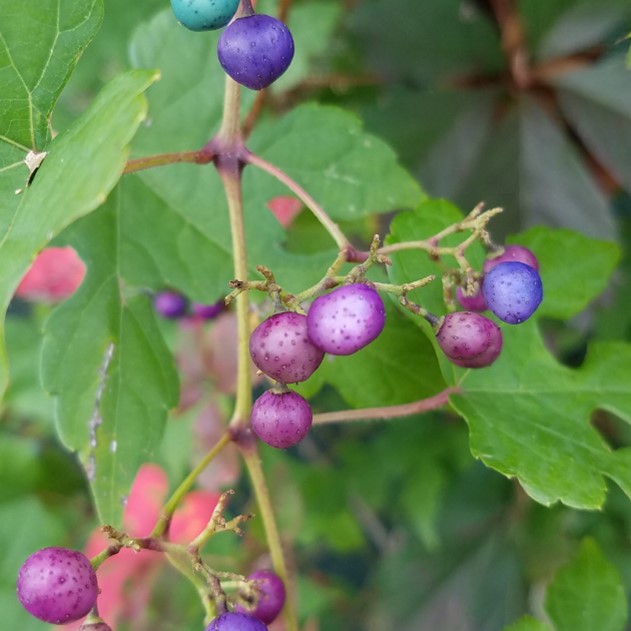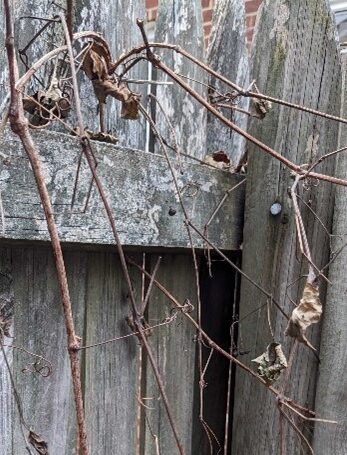THE LEAFLET

Most UN-Wanted: Porcelain Berry
The Casey Trees’ most unwanted invasive plant species series continues with week two looking at another highly problematic, tree harming plant: Porcelain Berry.
With three more weeks to go, Casey Trees will be looking at invasive plant species our staff encounters most while restoring, enhancing, and protecting our tree canopy. Invasive species are one of our urban forest’s largest threats. These non-native plants cause stress and environmental harm as they lack natural predators and competition.
Last week we covered English Ivy, known for causing great damage to trees by weighing down branches, blocking sunlight to leaves, damaging bark via rot, and transferring Bacterial Leaf Scorch. Learn more about how to spot and remove English Ivy by reading last week’s Leaflet.
Porcelain Berry can cause great damage to trees by creating dense, tangled webs that block out sunlight to native plants. The invasive’s blanketing effect not only cuts off resources such as sunlight to young trees, but also strangles them. Additionally, it can take over trees reaching 20 feet in height.
Porcelain Berry originates from Asia and was introduced to the United States in the late 19th century to be used as an ornamental plant. Still sold in the US today, Porcelain Berry causes significant damage to trees throughout the DMV.
How to spot Porcelain Berry:
 Porcelain Berry can be spotted by its heart-shaped leaves with rough edges. In summer months, the invasive sprouts white flowers that turn to berries in September and October. These berries range in colors of white, yellow, purple, and blue.
Porcelain Berry can be spotted by its heart-shaped leaves with rough edges. In summer months, the invasive sprouts white flowers that turn to berries in September and October. These berries range in colors of white, yellow, purple, and blue.
In the Winter, Porcelain Berry can be identified only by its stem or if there are any berries or identifying features remaining from the Fall. The stem is beige in color, smooth on young stems, and covered with lenticels (raised pores that look like small dots on the woody vine’s bark). The vine often grows in a zig-zag pattern as well.
During Winter months, Porcelain Berry may be confused with identical looking native vines, like Virginia Creeper or native grape vines. Unlike native grape vines, Porcelain Berry bark does not shred or peel with the inside of its stem being white, and its bark is smoother and vine grows more zig-zag in form, unlike Virginia Creeper. However, it is advised that even native vine growth on trees be removed, or at a minimum, limited and controlled. Removing any vine growth often improves tree health.
- When identifying Porcelain Berry in winter, there may be some remaining dried leaves or berries still present on the vine.
- Porcelain Berry grows in a zig-zag pattern and its bark is smooth with lenticels (raised pores that look like small dots on the woody vine’s bark).
How to remove Porcelain Berry:
Like English Ivy, Porcelain Berry can be removed year-round; however, it is best to remove this invasive species in the winter when other vines such as poison ivy are dormant. If you are removing the plant outside of the winter months, it is recommended to be removed in the fall or early spring before flowers start to bud. While removing, make sure to wear long sleeves and pants along with protective gloves to ensure protection from other plants.
It is best to remove Porcelain Berry as soon as it is detected, the earlier it is spotted the better. Repeated removal sessions will be necessary as seeds and roots may still be in the soil. During removal, make sure to pick up any berries to prevent them from spreading seeds.
It is recommended to lift the vines away from the ground or plant it is covering and use pruners, loppers, or shears to cut at stems. Follow by removing the vines by hand. Make sure all plants covered by the invasive are clean from its vines.
Casey Trees continues to work with partners to remove invasive species from sites throughout the DMV. Join us in continuing the fight against invasive species by following these steps to remove Porcelain Berry in your own yard. Additionally, join us for our upcoming invasive removals that take place during our winter and summer tree care seasons.


